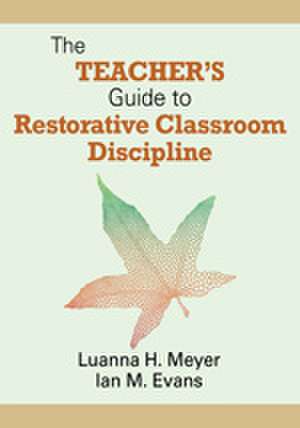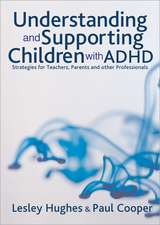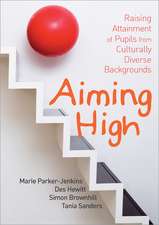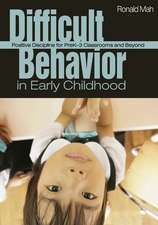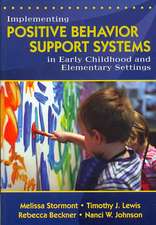The Teacher's Guide to Restorative Classroom Discipline
Autor Luanna H. Meyer, William John M. Evansen Limba Engleză Paperback – 25 iul 2012
Preț: 300.21 lei
Nou
Puncte Express: 450
Preț estimativ în valută:
57.45€ • 59.76$ • 47.43£
57.45€ • 59.76$ • 47.43£
Carte tipărită la comandă
Livrare economică 15-29 aprilie
Preluare comenzi: 021 569.72.76
Specificații
ISBN-13: 9781412998611
ISBN-10: 1412998611
Pagini: 216
Dimensiuni: 178 x 254 x 13 mm
Greutate: 0.39 kg
Ediția:1
Editura: SAGE Publications
Colecția Corwin
Locul publicării:Thousand Oaks, United States
ISBN-10: 1412998611
Pagini: 216
Dimensiuni: 178 x 254 x 13 mm
Greutate: 0.39 kg
Ediția:1
Editura: SAGE Publications
Colecția Corwin
Locul publicării:Thousand Oaks, United States
Recenzii
"Professors Meyer and Evans have done it again! This terrific book continues, enriches, and expands on their vital contributions to the practice of positive schooling for students with behavioral difficulties and, indeed, for all students. I have admired and benefited from the writings of Meyer and Evans for decades, and this book deepens my appreciation. The guidance they provide is insightful, clear, evidence-based, and eminently practical. The perspectives and strategies found herein will be of tremendous value to schools and teachers and, ultimately, to the students who depend on high-quality education and discipline. I give this book my highest recommendation."
"Meyer and Evans provide a framework for understanding and implementing restorative practices that create a positive school climate. They illustrate how it is possible and necessary to establish meaningful behavior change without the use of punitive consequences. Educators will identify with the relevant chapter examples of students who challenge our school communities and the development of proactive and culturally responsive instructional strategies. This reflective process will guide educators in defining relationships with students that are based on mutual trust, respect, and restore dignity during difficult times. This strength-based approach will cause educators to reexamine their interactions to ensure all students are valued, understood, and encouraged to engage in goal oriented life outcomes."
"Restorative practices enable students with conduct disorders to become active participants in problem solving for today and their future. This guide offers all school staff the knowledge to create schoolwide change that supports students, staff, and families."
The Teacher's Guide to Restorative Classroom Discipline represents the next generation of work in positive behavioral supports and school discipline that is sufficiently complex, appropriately comprehensive, and incredibly authentic. Finally, teachers, administrators, and school support staff have a framework that "rings true," pulling together previously isolated and oftentimes singularly considered practices of behavioral sciences, culturally responsive and effective teaching, and school-wide systems change. Meyer and Evans' groundbreaking work on restorative discipline recognizes that sound behavioral principles and effective teaching practices are used and useful only within settings that acknowledge personal histories, relationships, and the cultural values of students and families. It is no surprise that the authors have spent the majority of their careers in island ecosystems with large indigenous populations, where maintaining the delicate and intricate balance of elements are absolutely crucial, necessary, and lifesaving. The Guide's user-friendly style and well-organized content that includes anecdotes, classroom examples, planning guides, and scripts make this a valuable resource and necessary reading for every teacher and administrator.
"Meyer and Evans provide a framework for understanding and implementing restorative practices that create a positive school climate. They illustrate how it is possible and necessary to establish meaningful behavior change without the use of punitive consequences. Educators will identify with the relevant chapter examples of students who challenge our school communities and the development of proactive and culturally responsive instructional strategies. This reflective process will guide educators in defining relationships with students that are based on mutual trust, respect, and restore dignity during difficult times. This strength-based approach will cause educators to reexamine their interactions to ensure all students are valued, understood, and encouraged to engage in goal oriented life outcomes."
"Restorative practices enable students with conduct disorders to become active participants in problem solving for today and their future. This guide offers all school staff the knowledge to create schoolwide change that supports students, staff, and families."
The Teacher's Guide to Restorative Classroom Discipline represents the next generation of work in positive behavioral supports and school discipline that is sufficiently complex, appropriately comprehensive, and incredibly authentic. Finally, teachers, administrators, and school support staff have a framework that "rings true," pulling together previously isolated and oftentimes singularly considered practices of behavioral sciences, culturally responsive and effective teaching, and school-wide systems change. Meyer and Evans' groundbreaking work on restorative discipline recognizes that sound behavioral principles and effective teaching practices are used and useful only within settings that acknowledge personal histories, relationships, and the cultural values of students and families. It is no surprise that the authors have spent the majority of their careers in island ecosystems with large indigenous populations, where maintaining the delicate and intricate balance of elements are absolutely crucial, necessary, and lifesaving. The Guide's user-friendly style and well-organized content that includes anecdotes, classroom examples, planning guides, and scripts make this a valuable resource and necessary reading for every teacher and administrator.
Cuprins
Introduction to the Guide
Section I. Setting the Context
1. Restorative Classroom Discipline
2. Behavior Expectations for Schools and Classrooms
3. Home-School and Community Relationships
Section II. Putting the Model in Place
4. Classroom Climate and Cultural Responsiveness
5. School and Classroom Support Structures
6. Interventions for Individual Students—Child-Focused Planning
7. Interventions for Individual Students—Principles in Practice
8. Reflecting Schoolwide Policy in Teacher Practice
Section III: Evaluating Effectiveness and Updating Practice
9. User-Friendly Evaluation Tools and Approaches
10. Professional Development Needs Assessment
References
Index
Section I. Setting the Context
1. Restorative Classroom Discipline
2. Behavior Expectations for Schools and Classrooms
3. Home-School and Community Relationships
Section II. Putting the Model in Place
4. Classroom Climate and Cultural Responsiveness
5. School and Classroom Support Structures
6. Interventions for Individual Students—Child-Focused Planning
7. Interventions for Individual Students—Principles in Practice
8. Reflecting Schoolwide Policy in Teacher Practice
Section III: Evaluating Effectiveness and Updating Practice
9. User-Friendly Evaluation Tools and Approaches
10. Professional Development Needs Assessment
References
Index
Notă biografică
Descriere
Designed for use with The School Leader's Guide to Restorative Discipline, this guide helps teachers create positive classroom environments based on clear expectations for student behavior.
